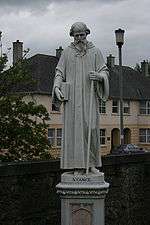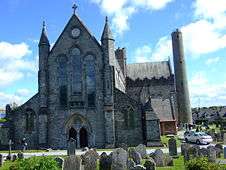Cainnech of Aghaboe
| Saint Cainnech of Aghaboe | |
|---|---|
|
Saint Cainnech statue in Kilkenny | |
| Confessor | |
| Born |
c. 515 A.D. Glengiven, Ireland |
| Died |
600 (aged 84–85) Aghaboe, Ireland |
| Venerated in |
Roman Catholic Church Eastern Orthodox Church Anglican Communion |
| Canonized | pre-congregation |
| Feast |
11 October 1 or 14 August |
| Patronage | the shipwrecked |
Saint Cainnech of Aghaboe (515/16–600), also known as Saint Canice in Ireland, Saint Kenneth in Scotland, Saint Kenny and in Latin Saint Canicus, was an Irish abbot, monastic founder, priest and missionary during the early medieval period. Cainnech is one of the Twelve Apostles of Ireland[1] and preached Christianity across Ireland and to the Picts in Scotland.[2] He wrote a commentary on the Gospels, which for centuries was known as the Glas-Choinnigh or Kenneth's Lock or the Chain of Cainnech.[3]
Most of what is written about Cainnech's life is based on tradition, however he was considered a man of virtue, great eloquence and learning. His feast day is commemorated on 11 October in the Roman Catholic Church and the Eastern Orthodox Church according to their respective calendars (Gregorian or Church Julian) with additional feast days on 1st or 14 August in the Eastern Orthodox Church.
Introduction
A lot of what is known of Cainnech comes from legend. However, he is documented by Saint Adomnán (also known as Eunan), the ninth abbot of Iona who died in 704. Adomnán was a hagiographer and his greatest work Vita Columbae or Life of St. Columba contains references to Cainnech.[4][5]
Cainnech's background

Cainnech was born in 515 or 516, at Glengiven, near Dungiven in Ireland.[5] His full name was Cainnech moccu Dalánn.[6]
Cainnech's father Lughadh Leithdhearg was descended from the CorcoDalann or Ui Dalainn, a tribe whose ancestor, Dalann, is traced back to Fergus (King of Ulster), son of Ross, son of Rudhraighe. The Corco-Dalann were from an island referred to as "Insula Nuligi", and is usually identified with Inis-Doimhle or Inis-Uladh, which is now the Little Island, in the River Suir, south-east of Waterford.[3]
Lughadh was a distinguished bard, a highly trained, professional itinerant poet. Lughadh settled at Glengiven, in what is now County Londonderry. Lughadh ended up under the favour and protection of the chief of Cianachta, and became the tutor of the chieftain's son, Geal Breagach.[7]
Cainnech's mother was called Maul or Mella.[8] She attained an eminent degree of sanctity. The church of Thompleamoul or Capella Sanctae Maulae seu Mellae, beside Kilkenny city, was dedicated to God under her invocation.
Early life

In early Christian Ireland the druid tradition collapsed, with the spread of the new faith. The study of Latin and Christian theology flourished in monasteries.
Cainnech spent his early years watching his chieftain's flocks. In 543 Cainnech became a pupil at Finnian's monastic school at Clonard. During the sixth century, some of the most significant names in the history of Irish Christianity studied at the Clonard monastery.[1] Twelve students who studied under St. Finian became known as the Twelve Apostles of Ireland, Cainnech was one of these. It was at Clonard that Cainnech became a friend and companion of St Colmcille (Columba).
In 544 he studied under St. Mobhi at the school of Glasnevin, with Kieran of Clonmacnoise and St. Comgall of Bangor. When plague scattered that community, he went to Saint Cadoc's monastery of Llancarfan in Glamorganshire in Wales, where he was ordained a priest in 545.[9]
He left for Rome to obtain the blessing of the reigning pontiff. In 550 he had returned to Glengiven, where he converted his foster-brother, Geal-Breagach, who afterwards assisted him in founding Drumachose, in nearby Limavady.
Scotland
In 565 Cainnech joined Columba in Scotland, where he is known as St. Kenneth. Adamnan tells of the arrival of Cainnech, on Iona. St. Columba had a prophecy of a "certain holy and excellent man, who will arrive here among us before evening." According to Adamnan, God provided Cainnech with a safe and calm crossing, even though the sea was perilous and stormy that day. St. Columba received him that evening with all honour and hospitality.[4]
Cainnech built a church in the place now known as Saint Andrews.[10] He built monastic cells on the island of Ibdon and Eninis, an oratory called Lagan-Kenny on the shores of Loch Laggan (the remains of which are marked on the OS map), and a monastery in Fife on the banks of the Eden. Cainnech's name is still recalled in the ruins of an ancient church, Kil-Chainnech on Tiree Island, in a burial ground, Kil-Chainnech, in Iona and Inch Kenneth off Mull.[11]
Return to Ireland
Cainnech spent a good deal of his time in County Meath and Ossory in what is now County Laois. In Ossory he had a good repute with the king, Colmann son of Feradach. Colman gave him grants of land including Aghaboe ("the field of the Ox") which became his principal monastery.[5] Aghaboe grew in importance, and in the 7th century sent St. Feargal as a missionary to the church of Salzburg, Austria. Aghaboe was for a time the site of the bishop's see until under Norman influence in the twelfth century the see transferred from Aghaboe to Kilkenny.[9] In 1346 Diarmaid Mac Giollaphádraig burned the town of Aghaboe, and completely destroyed Cainnech's shrine along with his relics.[3]
Kilkenny (Irish: Cill Chainnigh "The Church of Cainnech") was originally the name of a church erected by or dedicated to Cainnech, but was afterwards extended to the townland and parish.[12] Kilkenny was one of the last parts of Ireland to be converted to Christianity. Tradition asserts that in 597, Cainnech led a Christian force to Kilkenny to eliminate the last bastion of Druidic rule in Ireland. The last Archdruid of Ireland had retired with his Council to a mound in Kilkenny for safety. Cainnech led an army there and overcame them. He founded a monastery near what is now the Church of Ireland's St. Canice's Cathedral.[9] He died and was interred at Abbey of Aghaboe in 599/600.
Chain of Cainnech
In his old age Cainnech retired to an island in what was once Loch Cree, and wrote a commentary on all four Gospels. This became known as Glass Kinnich (Glas-Chainnigh) or Chain of Cainnech,[5] This was long preserved in his church and became a continuous commentary in the Middle Ages.
Patronage
Cainnech is the patron of Aghaboe and together with St. Ciarán of Saigir, is one of the patrons of Kilkenny and the historic kingdom of Osraige.[8] St. Cainnech is also the patron saint of the shipwrecked.[11]
See also
Places bearing his name
- [NSW. Australia] St.Canice's church Katatomba
- Kilkenny City (Irish: Cill Chainnigh "The Church of Cainnech"), Ireland.
- County Kilkenny, Ireland; named after the county's principal city.
- St. Canice's Church in Finglas, Dublin.
- An ancient church, Kil-Chainnech on Tiree Island, Scotland.
- A burial ground, Kil-Chainnech, in Iona, Scotland
- An oratory called Lagan-Kenny on the shores of Lough Lagan, Scotland.
- Kilchenzie in Cantyre.
- The remains of St Kenneth's Church (shown on OS maps) near Loch Laggan, in Scotland
- St. Canice Church, Roslyn Street- Sydney, Australia
- St. Canice Church, Nevada City, California [13]
- St. Kenneth Church, Plymouth, Michigan [14]
- St Canice's Church and St Canice's School in Westport, New Zealand
- St Canice's Church in Lockington, Victoria, Australia
Troparion of St Cainnech (tone 8)
This is a Troparion of St Cainnech.
In honour thou dost rank with Ireland's Enlightener,
O Lover of the Desert, Composer of sacred verse,
Father of Monks and Founder of Monasteries, O Father Cainnech.
Labouring for Christ, both in thy native land and in Scotland,
thou art a tireless intercessor for the faithful.
Pray for us who hymn thee, that despite our frailty we may be granted great mercy.
Notes
- 1 2 Grattan-Flood, William. "The Twelve Apostles of Erin." The Catholic Encyclopedia. Vol. 1. New York: Robert Appleton Company, 1907. 10 Feb. 2013
- ↑ "St. Canice", Catholic Online
- 1 2 3 O'Kane, Michael. "St. Canice." The Catholic Encyclopedia. Vol. 3. New York: Robert Appleton Company, 1908. 10 Feb. 2013
- 1 2 Adamnan, "Life of St. Columba", Medieval sourcebook, Fordham University
- 1 2 3 4 Baring-Gould, S. and Fisher, John, The Lives of the British Saints, Vol.II, p.56, Charles J. Clark, London, 1908
- ↑ Sharpe, Richard, Adomnán of Iona: Life of Saint Columba, pp. 262–263. Moccu is not a patronymic but rather the name of a kin group, in this case the Corcu Dalánn, in later sources, when it was no longer current, moccu was sometimes mistakenly read as a patronymic such as mac or mac h-ui; see Charles-Edwards, T. M., Early Christian Ireland, pp. 96–100.
- ↑ "St Canice of Aghaboe", The Parish Church of St George, Belfast
- 1 2 Smith, William, and Wace, Henry. A Dictionary of Christian Biography, Literature, Sects and Doctrines, Vol.1, p.382, Little, Brown & Company, 1877
- 1 2 3 Duffy, Patrick. "St. Canice of Dungiven", Catholic Ireland.net
- ↑ "saintc2w.htm".
- 1 2 "Kilchenzie's Saint, Kenneth (Cainnech) Of Aghaboe, Patron of The Shipwrecked", Kintyre on Record
- ↑ ODonovan 1839.
- ↑ Diocese of Sacramento
- ↑ St. Kenneth's, Plymouth, MI
References
- Clyn, Friar John (2007), Williams, Bernadette, ed., The Annals of Ireland, Four Courts Press, ISBN 978-1-84682-034-2.
- Adamnan, Life of Saint Columba.
- McNeill, ed. (1931), Liber primus Kilkenniensis.
- Codex Salmanticensis.
- O'Donovan, John (1839), Ordnance Survey Letters.
- Ulster (1957), The Annals of Ulster.
- Graves, Rev. James (1857), The History, Architecture, and Antiquities of the Cathedral Church of St. Canice, Kilkenny, Grafton Street, Dublin.: Hodges, Smith, & co., p. 22.
- John, Lanigan (1829), An ecclesiastical history of Ireland, from the first introduction of Christianity to the beginning of the thirteenth century, Oxford University: J. Cumming.
- Walsh, Thomas (1854), History of the Irish Hierarchy: With the Monasteries of Each County, Biographical Notices of the Irish Saints, Prelates, and Religious, New York Public Library: D. & J. Sadlier & co..
- Lanigan, John (1829), An Ecclesiastical History of Ireland, from the First Introduction of Christianity Among the Irish, to the Beginning of the Thirteenth Century: Compiled from the Works of the Most Esteemed Authors ... who Have Written and Published on Matters Connected with the Irish Church; and from Irish Annals ..., Harvard University: D. & J. Sadlier & co..
- Smith, William (1877), A Dictionary of Christian Biography, Literature, Sects and Doctrines A to D Part One, Harvard University: Kessinger Publishing (published 2004), p. 476, ISBN 1-4179-4801-9.
Further reading
- Baring-Gould, S, "S. Cainnech", The Lives of the British Saints;The Saints of Wales, Cornwall and Irish Saints, V2, (1908),Kessinger Publishing, ISBN 0-7661-8765-9 (2005).
- O'Donovan, John, The Banquet of Dun Na N-Gedh and The Battle of Magh Rath, For the Irish Archaeological Society, (1842) ISBN 978-0-7661-8765-8.
External links
- A hymn to Columcille attributed to Cainnech, original Irish text from Rawlinson B 505 at Thesaurus Linguae Hibernicae
- A poem in praise of Cainnech attributed to Columcille, original Irish text from Royal Irish Academy MS 23 N 10 at Thesaurus Linguae Hibernicae
- Omnium Sanctorum Hiberniae; Saint Canice of Kilkenny, October 11:
- Catholic Forum

